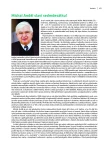OxLDL/β2-glycoprotein I complex as a pro-atherogenic autoantigen. Is atherosclerosis an autoimmune disease?
Authors:
Pavel Kraml
Authors‘ workplace:
Centrum pro výzkum diabetu, metabolizmu a výživy II. interní kliniky 3. LF UK a FN Královské Vinohrady, Praha
Published in:
Vnitř Lék 2016; 62(Suppl 4): 48-51
Category:
Reviews
Overview
Oxidation of atherogenic low-density lipoproteins (LDL) plays a key role in the pathogenesis of atherosclerosis. Oxidation stress and inflammation are closely interrelated and they can potentiate one another. In the subendothelial space of the arterial intima, monocytes/macrophages become activated and phagocyte oxidized LDL (oxLDL) via scavenger receptors. It has been demonstrated that oxLDL forms complex with plasma β2-glycoprotein I (β2GPI) and becomes autoantigenic triggering synthesis of specific antiphosholipid antibodies. It has been documented that oxLDL/β2GPI in immune complex with IgG autoantibody is internalized by macrophages through the Fcγ receptor. Increased levels of oxLDL/β2GPI were first observed in patients with systemic lupus erythematodes (SLE) and antiphospholipid syndrome (APS), further in individuals with coronary heart disease (CHD) and type 2 diabetes mellitus (DM2T). In a prospective study, initial plasma concentrations of oxLDL/β2GPI correlated with the number and severity of cardiovascular events in patients with chronic CHD over a 2-year period.
Key words:
atherosclerosis – β2-glycoprotein I – inflammation – oxidative stress – oxLDL
Sources
1. Anderson MT, Staal FJ, Gitler C et al. Separation of oxidant-initiated and redox-regulated steps in the NF-kappa B signal transduction pathway. Prc Natl Acad Sci USA 1994; 91(24): 11527–11531.
2. Flohé L, Brigelius-Flohé R, Saliou C et al. Redox regulation of NF-kappa B activation. Free Radic Biol Med 1997; 22(6): 1115–1126.
3. Murphy JE, Tedbury PR, Homer-Vanniasinkam S et al. Biochemistry and cell biology of mammalian scavenger receptors. Atherosclerosis 2005; 182(1): 1–15.
4. Brown MS, Goldstein JL. A Receptor-Mediated Pathway for Cholesterol Homeostasis. Science 1986; 232(4746): 34–47.
5. de Villiers WJ, Smart EJ. Macrophage scavenger receptors and foam cells formation. J Leukoc Biol 1999; 66(5): 740–746.
6. Hasunuma Y, Matsuura E, Makita Z et al. Involvement of beta 2-glycoprotein I and anticardiolipin antibodies in oxidatively modified low-density lipoprotein uptake by macrophages. Clin Exp Immunol 1997; 107(3): 569–573.
7. Lozier J, Takahashi N, Putman FW. Complete amino acid seqnence of human plasma β2glycoprotein I. Proc Natl Acad Sci USA 1984; 81(12): 3640–3644.
8. Kristensen T, Schousbe I, Boel E et al. Molecular cloning gand mammalian expression of human beta 2-glycoprotein I cDNA. FEBS Lett 1991; 289(2): 183–186.
9. Agar C, van Os GM, Mörgelein M et al. Beta2-Glycoprotein I can exist in two conformations: implication for our understanding of the antiphospholipid syndrome. Blood 2010; 116(8): 1336–1343. Dostupné z DOI: <http://dx.doi.org/10.1182/blood-2009–12–260976>.
10. George J, Harats D, Gilburd B et al. Immunolocalization of beta2-glycoprotein I (apoliporotein H) to human atherosclerotic plaques: potential implications for lesion progression. Circulation 1999; 99(17): 2227–2230.
11. Kobayashi K, Kishi M, Atsui T et al. Circulating oxidized low density lipoprotein forms complexes with β2-glycoprotein I: implication as an atherogenic autoantigen. J Lipid Res 2003; 44(4): 716–726.
12. Ylä-Herttuala S, Palinski W, Rosenfeld ME et al. Evidence for the presence of oxidatively modified low density lipoprotein in atherosclerotic lesions of rabbit and man. J Clin Invest 1989; 84(4): 1086–1095.
13. Kajiwara T, Yasuda T, Matsuura E. Intracellular trafficking of β2-glycoprotein I complexes with lipid vesicles in macrophages: implications on the development of antiphospholipid syndrome. J Autoimmun 2007; 29(2–3): 164–173.
14. Matsuura E, Hughes GR, Khamashta MA. Oxidation of LDL and its clinical implication. Autoimmun Rev 2008; 7(7): 558–566. Dostupné z DOI: <http://dx.doi.org/10.1016/j.autrev.2008.04.018>.
15. Monroe DM, Key NS. The tissue factor-factor VIIa complex: procoagulant activity, tegulation, and multitasking. J Thromb Haemost 2007; 5(6): 1097–1105.
16. Malia RG, Kitchen S, Greaves M et al. Inhibition of activated protein C and its cofactor protein S by antiphospholipid antibodies. Br J Haematol 1990; 76(1): 101–107.
17. Ieko M, Sawada KI, Koike T et al. The putative mechanism of thrombosis in antiphospholipid syndrome: impairment of the protein C and the fibrinoltic systems by monoclonal anticardiolipidn antibodies. Semin Thromb Hemost 1999; 25(5): 503–507.
18. de Laat B, Eckmann CM, van Schagen M et al. Correlation between the potency of a beta2-glycoprotein I-dependent lupus anticoagulant and the level of resistance to activated protein C. Blood Coagul Fibrubikysus 2008; 19(8): 757–764. Dostupné z DOI: <http://dx.doi.org/10.1097/MBC.0b013e32830f1b85>.
19. Kobayashi K, Matsuura E, Liu Q et al. A specific ligand for β2-glycoprotein I mediates antibody-dependent uptake of oxidized low-density lipoproteins by macrophages. J Lipid Res 2001; 42(5): 697–709.
20. Liu Q, Kobayashi K, Inagaki J et al. w-Carboxyl variants of 7-ketocholesteryl esters are ligands for β2-glycoprotein I and mediate antibody-dependent uptake of oxidized LDL by macrophages. J Lipid Res 2002: 43(9): 1486–1495.
21. Greco TP, Conti-Kelly AM, Anthony JR et al. Oxidized-LDL/ β2-glycoprotein I Complexes Are Associated With Disease Severity and Increased Risk for Adverse Outcomes in Patients With Acute Coronary Syndromes. Am J Clin Pathol 2010; 133(5): 737–743. Dostupné z DOI: <http://dx.doi.org/10.1309/AJCP88WVRDRDFBAS>.
22. Ames PR j, Ortiz-Cadanas A, Garcia-De La Torre I et al. Rosuvastatin treatment is associated with a decrease of serum oxidised low-density lipoprotein/beta2-glycoprotein I complex concentration in type 2 diabetes. Br J Diabetes Vasc Dis 2010; 10(6): 292–299.
23. Lopez LR, Hurley BL, Simpson DF et al. Oxidized low-density lipoprotein/ β2-glycoprotein I complex I complexes and autoantibodies in patients with type 2 diabetes mellitus. Ann NY Acad Sci 2005; 1051: 97–103.
24. Kraml PJ, Syrovátka P, Potočková J et al. The oxidized low-density lipoprotein/ β2-glycoprotein I complex is associated with abdominal obesity in healthy middle-aged men. Ann Nutr Med 2013; 62(1): 7–13. Dostupné z DOI: <http://dx.doi.org/10.1159/000343049>.
Labels
Diabetology Endocrinology Internal medicineArticle was published in
Internal Medicine

2016 Issue Suppl 4
Most read in this issue
- Congenital hyperinsulinism: Loss of B-cell self-control
- Gestational Diabetes Mellitus
- Growth hormone, axis GH-IGF1 and glucose metabolism
- Education of a patient with diabetes – an integral part of complex therapy
